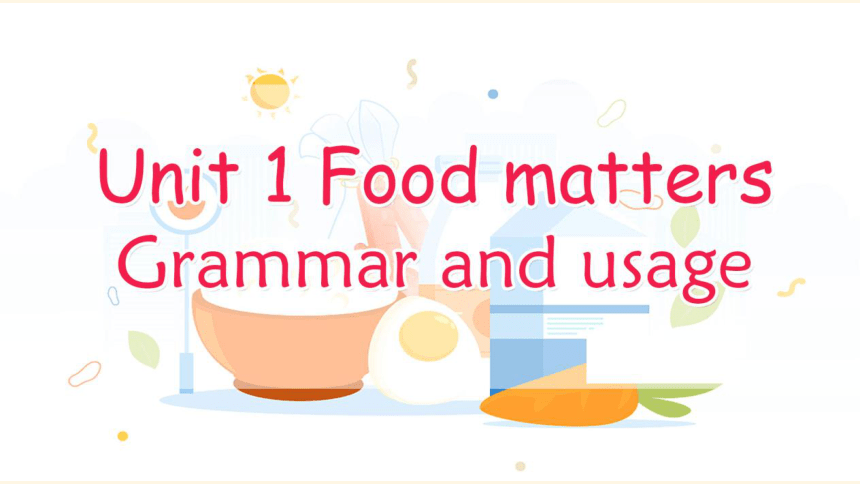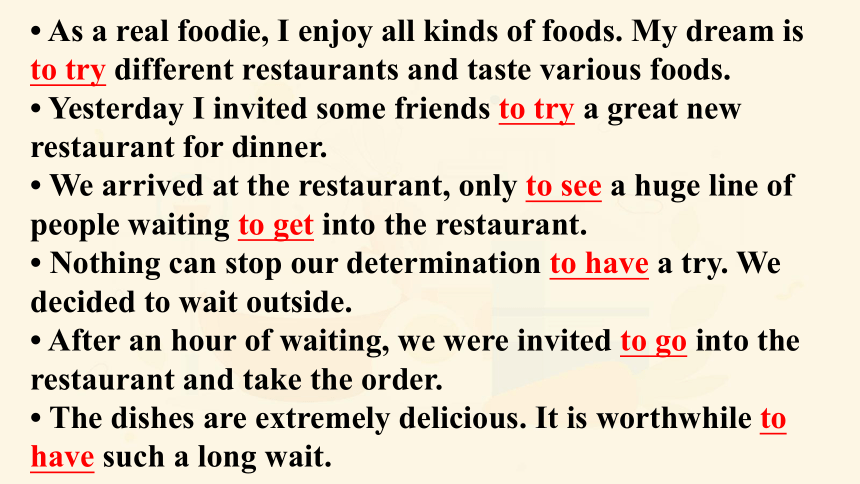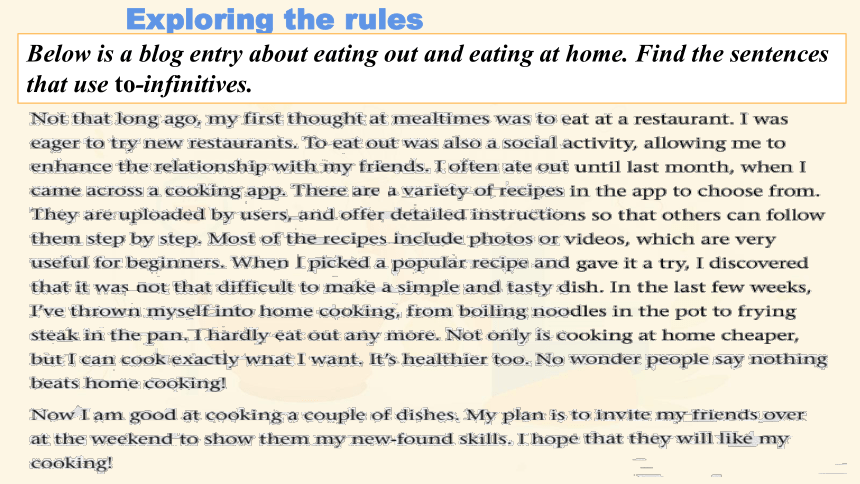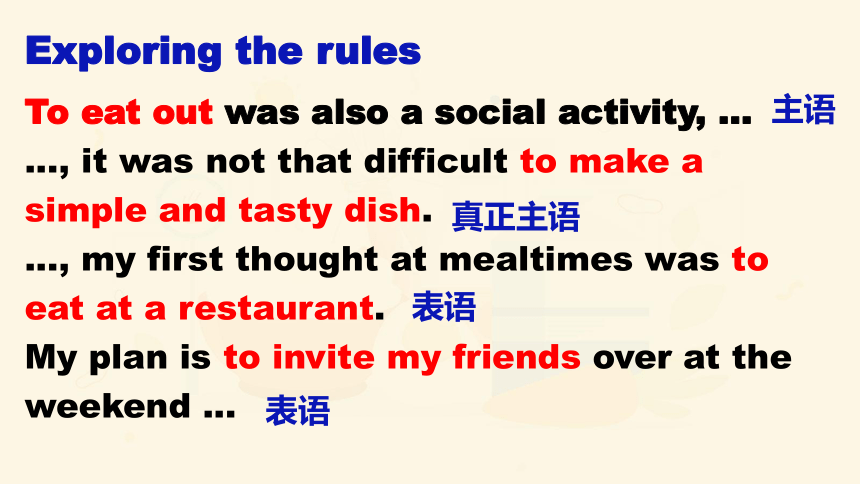译林版(2020) 选择性必修第一册 Unit 1 Food Matters Grammar and usage课件-(18张)
文档属性
| 名称 | 译林版(2020) 选择性必修第一册 Unit 1 Food Matters Grammar and usage课件-(18张) |  | |
| 格式 | zip | ||
| 文件大小 | 4.3MB | ||
| 资源类型 | 教案 | ||
| 版本资源 | 牛津译林版(2019) | ||
| 科目 | 英语 | ||
| 更新时间 | 2022-06-02 10:38:57 | ||
图片预览







文档简介
(共18张PPT)
Lead-in
As a real foodie, I enjoy all kinds of foods. My dream is to try different restaurants and taste various foods.
Yesterday I invited some friends to try a great new restaurant for dinner.
We arrived at the restaurant, only to see a huge line of people waiting to get into the restaurant.
Nothing can stop our determination to have a try. We decided to wait outside.
After an hour of waiting, we were invited to go into the restaurant and take the order.
The dishes are extremely delicious. It is worthwhile to have such a long wait.
Exploring the rules
Below is a blog entry about eating out and eating at home. Find the sentences that use to-infinitives.
App’s functions
(5) ________
In the last few weeks, the author engaged in home cooking.
Benefits
In the past, the author liked to eat (1) _______________.
Why
The author is eager to try new restaurants.
To eat out was also a social activity to (2) _______________________ with friends.
Then the author came across a cooking app last month.
There are lots of (3) _______ to choose from.
It offers (4) _________________ for users to follow step by step.
to cook exactly the author wants
(6) _________
at the restaurant
enhance the relationship
recipes
detailed instructions
cheaper
healthier
Mind map
To eat out was also a social activity, ...
..., it was not that difficult to make a simple and tasty dish.
..., my first thought at mealtimes was to eat at a restaurant.
My plan is to invite my friends over at the weekend ...
Exploring the rules
主语
真正主语
表语
表语
Working out the rule
When the to-infinitive is used as a subject, we usually use the preparatory subject at the beginning of the sentence.
The to-infinitive can also be used as a predicative. It usually comes after the verb .
it
be
Turn to Page 94
Grammar notes
Practice 1
He told us whether (have)a picnic was still under discussion.
(expose) to sunlight for too much time will do harm to one’s skin.
被邀请到你家做客真的是太荣幸了。
.
在家做饭准备环节需要花很长时间。
to have
It is a great honor to be invited to your family
It takes a long time to prepare for home-cooked meals.
Being exposed
你为我们做了这么多美味的菜真的是太好了。
It is nice of you to make so many tasty dishes for us.
在当今社会,我们学会做饭还是很有用的。
It is useful for us to learn how to cook.
不定式作主语时,常用形式主语的句型结构:
1. It+be+名词+to do sth.
It is still a problem to decide what we should do next.
2. It takes sb. + some time +to do sth.
It took me an hour to repair my bike.
3. It +be + adj. +for sb. to do sth.
适用这个句型的形容词有: difficult, easy, hard, important, impossible, necessary 等。
It’s very dangerous for children to cross the busy street.
4. It’s + adj. + of sb. + to do sth
适用用这个句型的形容词有: careless, clever, good, foolish, honest, kind, lazy, nice, right, silly, stupid, wise 等。
It’s clever of you to work out the maths problems.
= You are clever to work out the maths problems.
Understanding:
1. My goal is to enter my dream university.
2. Always remember in mind that your main task is to get this company running smoothly.
3. Whether we will succeed or not remains to be seen.
不定式作表语,通常用来说明主语的具体内容或性质。常见用作主语的名词有: aim, duty, dream, hope, idea, plan, wish, goal, task, ambition, purpose, work, job 等表示目标、意向、计划、任务的词。
Practice 2
1. Ladies and gentlemen, please remain ____ (seat) until the plane has come to a complete stop.
某些动词常用过去分词作表语修饰“人”:
be excited, be dressed in, be seated,
be satisfied, be interested, be determined,
be married, be used to, be tired,
be frightened, be amused, be puzzled,
be pleased, be worried about,
be concerned about, be encouraged 等。
seated
2. Another way of setting realistic goals is
(analyze) your short and long term objectives, keeping in mind your beliefs, values and strengths.
3. All we have to do is (push) the button.
4. 然而,烹饪对于我来说还有点挑战性。
However, cooking seems to be challenging for me.
5.是否我能学会做几个菜,以后见分晓。
It remains to be seen if I can cook a couple of dishes.
to analyze
(to) push
特别提醒:
1.当主语部分有实义动词do或do的某种形式时,作表语的不定式可以省略to.
All I could do mow is (to) keep silent.
2. 不定式和动名词作表语都可以用于表示主语“是什么”,但不定式作表语强调的是一次性的、具体的、将要发生的动作;动名词作表语强调的是一般性的,抽象的、经常发生的动作。如比较下面两个句子:
The man’s job is to paint the walls.
(表示一次性的、具体的、目前要做的事)
The man’s job is painting the walls.
(表示经常性的日常工作)
3. 某些动词不定式与be动词连用时常用主动形式表被动意义。如:
The house is to let.
Who is to blame for the accident
Lead-in
As a real foodie, I enjoy all kinds of foods. My dream is to try different restaurants and taste various foods.
Yesterday I invited some friends to try a great new restaurant for dinner.
We arrived at the restaurant, only to see a huge line of people waiting to get into the restaurant.
Nothing can stop our determination to have a try. We decided to wait outside.
After an hour of waiting, we were invited to go into the restaurant and take the order.
The dishes are extremely delicious. It is worthwhile to have such a long wait.
Exploring the rules
Below is a blog entry about eating out and eating at home. Find the sentences that use to-infinitives.
App’s functions
(5) ________
In the last few weeks, the author engaged in home cooking.
Benefits
In the past, the author liked to eat (1) _______________.
Why
The author is eager to try new restaurants.
To eat out was also a social activity to (2) _______________________ with friends.
Then the author came across a cooking app last month.
There are lots of (3) _______ to choose from.
It offers (4) _________________ for users to follow step by step.
to cook exactly the author wants
(6) _________
at the restaurant
enhance the relationship
recipes
detailed instructions
cheaper
healthier
Mind map
To eat out was also a social activity, ...
..., it was not that difficult to make a simple and tasty dish.
..., my first thought at mealtimes was to eat at a restaurant.
My plan is to invite my friends over at the weekend ...
Exploring the rules
主语
真正主语
表语
表语
Working out the rule
When the to-infinitive is used as a subject, we usually use the preparatory subject at the beginning of the sentence.
The to-infinitive can also be used as a predicative. It usually comes after the verb .
it
be
Turn to Page 94
Grammar notes
Practice 1
He told us whether (have)a picnic was still under discussion.
(expose) to sunlight for too much time will do harm to one’s skin.
被邀请到你家做客真的是太荣幸了。
.
在家做饭准备环节需要花很长时间。
to have
It is a great honor to be invited to your family
It takes a long time to prepare for home-cooked meals.
Being exposed
你为我们做了这么多美味的菜真的是太好了。
It is nice of you to make so many tasty dishes for us.
在当今社会,我们学会做饭还是很有用的。
It is useful for us to learn how to cook.
不定式作主语时,常用形式主语的句型结构:
1. It+be+名词+to do sth.
It is still a problem to decide what we should do next.
2. It takes sb. + some time +to do sth.
It took me an hour to repair my bike.
3. It +be + adj. +for sb. to do sth.
适用这个句型的形容词有: difficult, easy, hard, important, impossible, necessary 等。
It’s very dangerous for children to cross the busy street.
4. It’s + adj. + of sb. + to do sth
适用用这个句型的形容词有: careless, clever, good, foolish, honest, kind, lazy, nice, right, silly, stupid, wise 等。
It’s clever of you to work out the maths problems.
= You are clever to work out the maths problems.
Understanding:
1. My goal is to enter my dream university.
2. Always remember in mind that your main task is to get this company running smoothly.
3. Whether we will succeed or not remains to be seen.
不定式作表语,通常用来说明主语的具体内容或性质。常见用作主语的名词有: aim, duty, dream, hope, idea, plan, wish, goal, task, ambition, purpose, work, job 等表示目标、意向、计划、任务的词。
Practice 2
1. Ladies and gentlemen, please remain ____ (seat) until the plane has come to a complete stop.
某些动词常用过去分词作表语修饰“人”:
be excited, be dressed in, be seated,
be satisfied, be interested, be determined,
be married, be used to, be tired,
be frightened, be amused, be puzzled,
be pleased, be worried about,
be concerned about, be encouraged 等。
seated
2. Another way of setting realistic goals is
(analyze) your short and long term objectives, keeping in mind your beliefs, values and strengths.
3. All we have to do is (push) the button.
4. 然而,烹饪对于我来说还有点挑战性。
However, cooking seems to be challenging for me.
5.是否我能学会做几个菜,以后见分晓。
It remains to be seen if I can cook a couple of dishes.
to analyze
(to) push
特别提醒:
1.当主语部分有实义动词do或do的某种形式时,作表语的不定式可以省略to.
All I could do mow is (to) keep silent.
2. 不定式和动名词作表语都可以用于表示主语“是什么”,但不定式作表语强调的是一次性的、具体的、将要发生的动作;动名词作表语强调的是一般性的,抽象的、经常发生的动作。如比较下面两个句子:
The man’s job is to paint the walls.
(表示一次性的、具体的、目前要做的事)
The man’s job is painting the walls.
(表示经常性的日常工作)
3. 某些动词不定式与be动词连用时常用主动形式表被动意义。如:
The house is to let.
Who is to blame for the accident
同课章节目录
- Unit 1 Food matters
- Welcome to the unit
- Reading
- Grammar and usage
- Integrated skills
- Extended reading
- Project
- Unit 2 The Universal Language
- Welcome to the unit
- Reading
- Grammar and usage
- Integrated skills
- Extended reading
- Project
- Unit 3 The art of painting
- Welcome to the unit
- Reading
- Grammar and usage
- Integrated skills
- Extended reading
- Project
- Unit 4 Exploring poetry
- Welcome to the unit
- Reading
- Grammar and usage
- Integrated skills
- Extended reading
- Project
